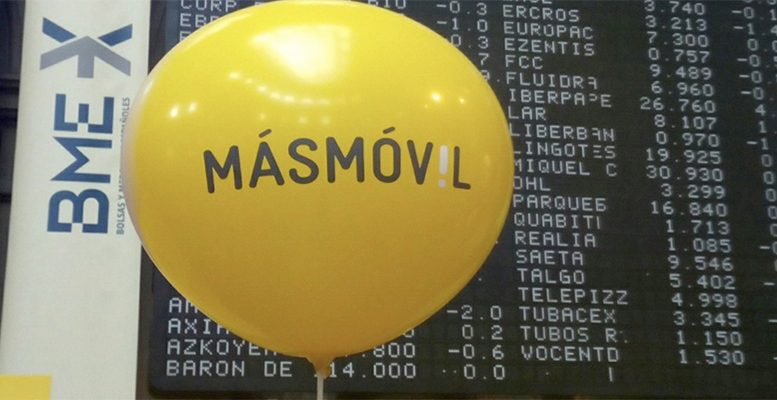José Benito de Vega | MasMovil has traded in the continuous market since July 2017, although it has done so since April 2012 in the alternative stock market. Since it began to trade in the continuous market it shares have doubled in value, even though during the last year it had seen ups and downs, falling 25% in the last 12 month compared to a fall in the Ibex of 3% in the same period.
Last February, MasMovil presented its results for 2018, with an increase of 12% in income (€1.451 billion), of 39% in EBITDA (€330 million) and 40% in net profit (€135 million).
The company’s total income was €1.451 billion in 2018, a 12% increase over 2017. Income for services were €1.183 million, an increase of 17.5% in the year, +23% organic growth (€1.235 million, that is excluding the impact of the accounting changes for the adoption of IFRS 15. Under IFRS 15, subsidies to terminals and other discounts will be classified as lower income rather than operational costs.
During 2018 the company added 1.4 million lines in postpaid mobile and broadband make a business, to reach 4.8 million postpaid mobile lines and 990,000 broadband lines. The total number of mobile lines was 6.8 million in December 2018 compared to 5 million the year before (+35% today). The operational evolution of the company has been very positive in recent quarters, with more than 100,000 net sign ups in broadband in five consecutive quarters and more than 190,000 net signups in postpaid mobile in six consecutive quarters.
MasMovil obtained an EBITDA of €330 million in the year, an increase of +39%, in line with the revised target, and €30 million more than the initial target of €300 million. Adjusted net profits were €135 million, and increased to 40% compared to the €97 million in 2017.
At the close of 2018, MasMovil had a net debt of €770 million (excluding the convertible debt of Provident, which if it were included would be €901 million), which means a net indebtedness of 2.3 times DN/EBITDA adjusted 2018. It is considered that the most relevant figure should exclude the convertible debt of Provident, given that the conversion price of €4.40 after the 2018 split is considerably less than the current trading price (€18.42 per share), at which it will be converted.
With the publication of these results, MasMovil made public it’s guidance for 2019 and 2020, which can be summarised in the following points:
Guidance 2019:
- Income for services €1.445 billion (+€262 million, +22%)
- EBITDA adjusted €450 million (+ €120 million, +36%), with a marginal increase of EBITDA of four percentage points (from 23% to 27%).
- Capex of €360 million, increase of €238 million and €122 million of maintenance.
- Recurring operational cash around €300 million.
Guidance 2020:
- Total income in the range of 1.852 – 1.875 billion €.
- EBITDA of €530-550 million, EBITDA margin on average of 29%.
- Capex €285 million, €140 of growth and €145 million of maintenance.
Conclusions:
MasMovil is the fourth telecommunications operator in Spain, a position which it has achieved thanks to a series of agreements with other operators, and which has helped it increase its market share. It strategy is based on an offer of value for money, which offers a quality product at a reduced price, which has served to significantly increase its client base of to reach a total of 7,750,000 lines, of which 4.8 million are postpaid mobile, 2 million prepaid mobile and 990,000 broadband clients. In addition it’s coinvestment strategy, developing the infrastructure for fixed and mobile networks jointly with Orange, allows it to secure greater returns, with margins far above those of the rest of the sector.
The nature of the business, with high levels of operational indebtedness, gives an advantage to operators with strong income growth, given that this translates into significant increases in profits. The growth profile of Masmovil justifies a premium in valuation, which is currently reduced (PER 2020 of 14.8X, EV/EBITDA 2020 of 6.6X, a premium of 14% and 10% respectively, compare to a PER 2020 of 13X and EV/EBITDA 2020 of 6X for the STOXX Europe 600 telecommunications). We would take advantage of moments of weakness in the market to construct an investment position in the company with a medium to long-term vision.





